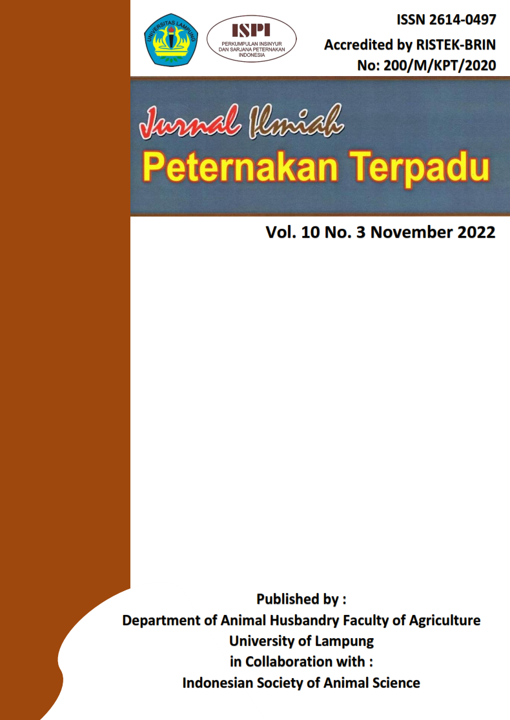Performance of Female Thin Tail Sheep Fed Ration Containing Fermented Shrimp Waste by EM-4
DOI:
https://doi.org/10.23960/jipt.v10i3.p277-288 Abstract View: 326
Abstract View: 326
Keywords:
Female Thin-Tailed sheep, Effective microorganism (EM)-4, Shrimp waste, PerformanceAbstract
The use of shrimp waste as ruminant feed is constrained by the presence of chitin which is difficult to digest. This study aimed to determine the use of shrimp waste fermented with EM-4 as additional feed for female Thin Tailed sheep. A total of 18 female Thin-Tailed sheep with a body weight of 10.35±0.88 kg were allocated to 3 ration treatments containing fermented shrimp waste with EM-4, namely 5%, 7.5% and 10%. The sheep were kept for 90 days at CV. Bungah Tani Djaya's Livestock to measure its performance. The results showed that the use of fermented shrimp waste up to 10% did not interfere with the performance of femaleThin-Tailed sheep with the average dry matter consumption, crude protein consumption, total digestible nutrient (TDN) consumption, daily body weight gain, and feed conversion were 340,29 g/head/day, 31.68 g/head/day, 195.63 g/head/day, 61.80 g/head/day, and 6.18 respectively. The results of the study concluded that the use of shrimp waste fermented with EM-4 up to 10% can be used as additional feed for female Thin-Tailed sheep.
Downloads
References
Agustono, Handyani, I.A. dan Lamid, M. 2009. Pemberian Probiotik pada Pengolahan Limbah Udang yang Dimasak dengan Tekanan Tinggi Terhadap Kandungan Protein Kasar dan Serat Kasar. Jurnal Ilmiah Perikanan dan Kelautan 1 (1): 73-77
AOAC. 2012. Official Methods of Analysis of AOAC International, 19th ed, USA
BPS (Badan Pusat Statistik). 2020. Produksi Perikanan Budidaya Menurut Komoditas Utama. Diunduh 2 Agustus 2022. https://www.bps.go.id/indicator/56/1513/1/produksi-perikanan-budidaya-menurut-komoditas-utama.html
Filawati, Mairizal, dan Suparjo. 2018. Pemanfaatan Limbah Udang Terfermentasi sebagai Pakan Ternak Sapi. Jurnal Ilmu-Ilmu Peternakan, 29-36.
Hamdan, A., Purwanto, B.P., Astuti, D.A. Atabany, A., dan Taufik, E. 2018. Respon Kinerja Produksi dan Fisologis Kambing Peranakan Ettawa terhadap Pemberian Pakan Tambahan Dedak Halus pada Agroekosistem Lahan Kering di Kalimantan Selatan. Jurnal Pengkajian dan Pengembangan Teknologi Pertanian, 21 (1):73.-84
Hernaman, I., Ainunisa, N., Hidayat, R., Tarmidi, A.R., Dhalika, T., Budiman, A., dan Rahmat, D. 2019. Perbandingan Model Pendugaan Total Digestible Nutrients (TDN) dan Protein Tercerna pada Domba Garut Jantan yang Diberi Ransum Berbasis Bahan Pakan Lokal. Jurnal Agripet, 19 (1): 1-6
Hernaman, I., Ayuningsih, B., Ramdani, D., Maisarah, M., dan Siswoyo. 2018. Performance of Female Garut Lambs Fed Diet in Different Ratio of Protein and Total Digestible Nutrients. Jurnal Veteriner, 19 (4): 568-573
Khotimah, D.F., Faizah, U.N., dan Sayekti, T. 2021. Protein sebagai Zat Penyusun Dalam Tubuh Manusia: Tinjauan Sumber Protein Menuju Sel. PISCES Proceeding of Integrative Science Education Seminar, 1 : 127-133
Manehat, S.E., Jelantik, I.G.N., dan Benu, I. 2020. Pengaruh Pemberian Pakan Komplit Fermentasi Berbasis Serasah Gamal Dan Batang Pisang Dengan Imbangan Yang Berbeda Terhadap Tingkah Laku Makan Kambing Kacang. Jurnal Nukleus Peternakan, 7 (1):75-85
Mirzah. 2006. Pengaruh Pengukusan terhadap Kualitas Protein Limbah Udang yang Telah Direndam Dengan Filtrat Abu Sekam. Jurnal Peternakan Indonesia, 11 (2): 141-150.
Mirzah, Yumaihana, dan Filawati.2008. Pemakaian Tepung Limbah Udang Hasil Olahan sebagai Pengganti Tepung Ikan dalam Ransum Ayam Broiler. Makalah Ilmiah. Fakultas Peternakan, Universitas Adalas Padang.
Nasoetion, A.H. 1992. Panduan Berpikir dan Meneliti Secara Ilmiah Bagi Remaja. Gramedia. Jakarta
Naufal, R., Rahmat, D., Ayuningsih, B. dan Santoso, F.T., Dhalika T. dan Hernaman, I. 2022. Kurva Pertambahan Bobot Badan Domba Garut Jantan 13-16 Bulan Diberi 80% Hijauan dan 20 % Konsentrat. ZIRAA’AH, 47 (1): 1-9.
Nurcahyani, E., Mutmainah, N.A., Farisi, S., dan Agustrina. R. 2019. Analisis Kandungan Karbohidrat Terlarut Total Planlet Buncis (Phaseolus vulgaris L.) Menggunakan Metode Fenol-Sulfur Secara In Vitro. Analit: Analytical and Environmental Chemistry, 4 (1):73-80
Suryaningsih, L dan Parakkasi, A. 2006. Pengaruh Pemberian Tepung Cangkang Udang (Karapas) Sebagai Sumber Khitin Dalam Ransum terhadap Kadar LDL (Low Density Lipoprotein), HDL (High Density Lipoprotein), dan Persentase Karkas. Jurnal Ilmu Ternak , 6 (1): 63-67.
Purwaningsih, S. 2000. Teknologi Pembekuan Udang. Penerbit Penebar Swadaya. Jakarta.
Saenab, A., Laconi, E.B., Retnani, Y. dan Masud, M.S. 2010. Evaluasi Kualitas Pelet Ransum Komplit yang Mengandung Produk Samping Udang. JITV. 19 (3): 31 - 39.
Sudekum, K.H., Wolffram, S., Ader, P. and Robert, J.C. 2004. Bioavailability of Three Ruminally Protected Methionine Sources in Cattle. Anim. Feed Sci. Tech. 113 : 17-25.
Wencelova, M., Varadyova, Z., Mihalikova, K., Kisidayova, S. and Jalc, D. 2014. Evaluating The Effects of Chitosan, Plant Oils, and Different Diets on Rumen Metabolism and Protozoan Population in Sheep. Turk. J. Vet. Anim. Sci. 38:26-33.
Yulianingsih, R. dan Teken R. 2008. Fermentasi Tepung Kepala Udang dengan Enzim Kitase. Bul. Tek. Lit. Akuakultur, 7(1): 65 –68.
Downloads
Published
How to Cite
Issue
Section
License

Jurnal Ilmiah Peternakan Terpadu(JIPT) is licensed under a Creative Commons Attribution 4.0 International License.
Authors who publish with this journal agree to the following terms:
- Authors retain copyright and grant the journal right of first publication with the work simultaneously licensed under a Creative Commons Attribution License that allows others to share the work with an acknowledgement of the work's authorship and initial publication in this journal.
- Authors are able to enter into separate, additional contractual arrangements for the non-exclusive distribution of the journal's published version of the work (e.g., post it to an institutional repository or publish it in a book), with an acknowledgement of its initial publication in this journal.
- Authors are permitted and encouraged to post their work online (e.g., in institutional repositories or on their website) prior to and during the submission process, as it can lead to productive exchanges, as well as earlier and greater citation of published work (See The Effect of Open Access).





















